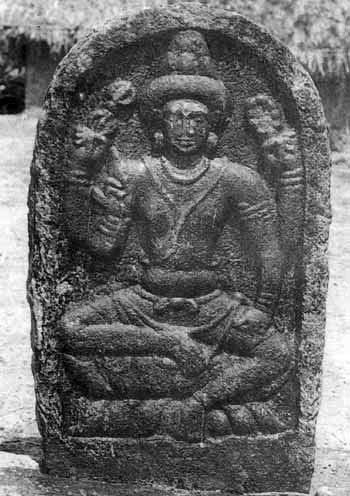
|
||||||||||||||||
|
| ||||||||||||||||
Discovery of an early sculpture of MurukanC. Veera Ragavan
This paper is a brief report of the recent discovery by the author of a rare early sculpture of Murukan with unique features and bearing an inscription in early Tamil script.1 Even though Murukan is the pre-eminent deity of the Tamils celebrated in literature from the Cankam Age,2 he is conspicuous by his absence from early Tamil inscription.3 Free-standing iconographic representation of Murukan are also rare in Tamilnadu before the 9th century AD.4 The earlier representations of the deity are mostly confined to the Somāskanda panels and niche figures in the Pallava temples and rock-cut shrines. The sculpture reported here is found in the open, outside a modern temple of Ayyappan in Kīlperumpākkam village, about two kilometres southeast of Villupuram town (headquarters of the district of the same name), about 160 kilometres south of Chennai. Along with this sculpture are found another Jyeshethā and a Śivalingam, leading to the surmise that there was an ancient Śiva temple here to which the present sculpture belonged. The sculpture is a bas-relief carved on an upright granite stele with a semi-circular top and straight edges on the other sides. The height of the stele is 108 cms, width 62 cms and thickness 20 cms. The image is encased with in a broad raised rim running along the edges of the slab. The figure is finely carved and still in an excellent state of preservation.5 The deity is seated on a lotus with his right leg folded and left leg hanging down. Seated figures6 of Subrahmanya on a lotus are rare, the present sculpture being probably the earliest.7 The deity is shown wearing a short conical basket-like head-gear (karanda-makuta) with a thick giralet of flowers (kannl) around the base. According to ancient Tamil tradition, kannl was the attribute of the warrior.8 The deity also wears the double shoulder-string (channavīra), another attribute of the warrior. Both the attributes, found mostly in the earlier sculpture of the Pallava period, emphasise the fact that Murukan was essentially a warrior-god. The deity is also adorned with large ear-rings (makara-kundala), a close-fitting necklace (kantikai), bracelets (kataka) around arms are wrists and anklets (kalal). He is also wearing a waist-band (udarabandha) with the knot in front. The folds of the dhoti are realistically depicted. The deity is shown with four arms. The upper right hand holds a weapon with a short handle, the thunderbolt (vajra or śakti) inherited from Indra when Subrahmanya became the warrior-god par excellence. The upper left hand holds a rosary (aksamāla) and the lower right hand a lotus bud. The lower left hand is shown resting on the left thigh. The rosary and the lotus bud are the attributes of Brahmā shared by Murukan in his capacity as the god of knowledge (su-brahmanya). The rosary is usually hold in the right hand, though instances of its being held in the upper left hand as in the present case are also known.9 All the three attributes, viz., rosary and the lotus bud, are known to Tamil literary tradition.10 It is however significant that three other important attributes in Tamil tradition viz., cēval koti and mayil mūrti are not depicted.11 These features begin to appear in the iconography of Murukan in the Tamil country only from a later period. A unique feature of the sculpture is the brief inscription appearing on the also forming the background to the sculpture in the narrow space below the armpits and above the thighs. With the exception of hero stones and Jain rock carvings, inscribed sculptures especially of the BrahmĀnical deities are rare in Tamilnadu.12 The inscription is in four lines. The first two lines are engraved below the right armpit of the deity and the next two lines below the left. Two letters in the first line are lost due to flaking of the rock surface. The rest of the inscription is well-preserved and legible. The inscription is in Tamil written in the Tamil script of the early Pallava period, but with an admixture of few vatteluttu letters. The inscription can be assigned on palaeographical grounds to ca. 7th century AD.13 The iconographical features belong to the same period. The text as it is laid out on the inscription is as follows:
na . . . k-korri kotti (tu) vittatu
Korri: Though only the latter half of the donor's name has survived, there is no doubt that Korri is the name of a woman. It is one of the names of the goddess of war and victory (Durgā) and was in common use as a personal name in the ancient Tamil country.14 Kottivittatu: The correct form should be kottuvittatu 'which was caused to be carved', from kottu 'to hammer, beat > to carve (as stone)'. cf. patimam kottuvittān '(he) caused the image to be carved' (Pallava inscription, 8th century AD).15 I hope that this unique inscribed sculpture, which is a welcome addition to the iconography of Murukan in Tamilnadu, will be protected from vandalism and weather by being removed to a safer place for permanent installation and preservation. Bibliography
IllustrationAn Early Inscribed Sculpture of Murukan (ca. 7th cent. AD) Kīlperumpākkam, Villupuram, (Villupuram Tk. & Pt.) FII French Institute of Ontology End Notes
The author: 66, Muthuvel Layout Villupuram - 605 602 India See also related articles:
|
